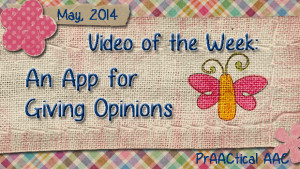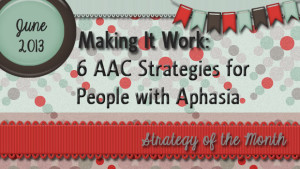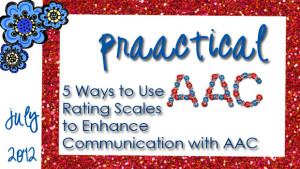May 18, 2014
by Carole Zangari -

In previous posts, we’ve written about our love of rating scales as an easy way to help people with significant language challenges express their preferences. We also posted a video of that in action with a little preschooler using Talking Mats to tell whether he liked or disliked various school activities. What could be better than getting the authentic input from our prAACtical friends? Two things, actually. An e-tool for this purpose A FREE app In this post, we share two demonstrations, one with an adult client and one with a child. You can see the demo of the app here. First, take a look at James. https://www.youtube.com/watch?v=SzAgGmLYpE0 Next, let’s take a peek at Matthew: https://www.youtube.com/watch?v=GIIv17eTgFI And, last, but not least, a link to the free Talking Mats app.
Filed under: Video of the Week
Tagged With: free, rating scale, Talking Mats
June 29, 2013
by Carole Zangari -

People with aphasia are often most successful when a number of different strategies are combined. In this post, we discuss a number of strategies that we can use in our therapy and teach to communication partners. Augmented Input We’ve written so many posts about aided language input that we’re almost embarrassed to bring it up again. Almost. It seems like no matter which age group or clinical population is the subject of our post, that strategy plays a central role. It is the same for people with aphasia with one exception. They benefit from a broader array of input cues, such as gestures, writing, and even pantomime. Augmented input is the term that is used to refer to oral language that is supplemented with pictures, print, gestures, pantomime, and the use of objects in the environment. By using these things as you speak, you enhance the ability of the person... [Read More...]
Filed under: Strategy of the Month
Tagged With: aided language input, aphasia, augmented input, communication book, rating scale, supplementation, tagged questions, written choice strategy
July 25, 2012
by Carole Zangari -

In an earlier post, we lamented the under-utilization of a quick and effective strategy: qualitative rating scales. You may not know them by that name, but we all know them. Also called Likert-type scales, we’ve seen these a multitude of times when we were asked to give an opinion. Strongly agree to Strongly Disagree. Excellent to Poor. Always to Never. – There are only a few guidelines to using these with AAC folks. One is to make sure to use appropriate visual supports. Literate AAC users may be very comfortable with text-only options, but for other learners, we need to add images so it makes sense to them. Another suggestion is to stick with an odd number of options: 5 seems to be the norm in clinical practice, but you can certainly adjust to fit the learner’s needs. For some, a 3-point scale would be best. Others may want more... [Read More...]
Filed under: PrAACtical Thinking
Tagged With: implementation ideas, intervention, rating scale, visual supports


